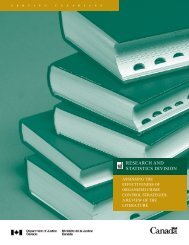National Threat Assessment 2008. Organised Crime - Politie
National Threat Assessment 2008. Organised Crime - Politie
National Threat Assessment 2008. Organised Crime - Politie
You also want an ePaper? Increase the reach of your titles
YUMPU automatically turns print PDFs into web optimized ePapers that Google loves.
forces all made their contributions. For the first time regional CPAs on organised<br />
crime were prepared according to a format. The bottlenecks that occurred whilst<br />
preparing these regional CPAs can be interpreted as teething problems. Since<br />
the publication of the first regional CPAs, various initiatives have been developed<br />
to draw attention to these bottlenecks and implement improvements.<br />
There were 22 regional CPA-ZGCs available for NTA 2008, which compares to<br />
none for NTA 2004. Nevertheless, the lack of regional CPA-ZGCs for Gooi en<br />
Vechtstreek, Kennemerland and Amsterdam-Amstelland must be seen as a<br />
shortcoming. This shortcoming was compensated for as much as possible by<br />
using data about these police regions that was available from the <strong>National</strong> <strong>Crime</strong><br />
Squad and the Supraregional <strong>Crime</strong> Squad, both of which have a national remit.<br />
In addition, in certain cases investigators contacted regional forces on their own<br />
initiative to collect targeted information for their specific subject.<br />
In the <strong>National</strong> <strong>Threat</strong> <strong>Assessment</strong> qualifications are assigned to criminal<br />
phenomena according to a fixed procedure. As explained in the discussion of the<br />
method, the qualification of a criminal phenomenon is based on intersubjectivity.<br />
This means that a different group of assessors could arrive at their own, possibly<br />
different, qualification. Bearing this in mind, it is important to emphasise the role<br />
of the line of reasoning. Greater value should be attached to the arguments that<br />
resulted in a particular qualification than to the qualification itself.<br />
In 2004 the first <strong>National</strong> <strong>Threat</strong> <strong>Assessment</strong> generally met with a positive<br />
response. There was some criticism because certain criminal phenomena that<br />
were deemed to be important by the critics had not been included. For example,<br />
there was no focus on ‘cannabis’ at all and too little attention was paid to<br />
‘fraud’. This is why the NTA 2008 project was launched based on a complete list<br />
of primary criminal activities, supplemented by a important criminal working<br />
methods. The intention was to make NTA 2008 ‘more complete’ than NTA 2004.<br />
Attention was also paid to organised crimes against property committed by<br />
supraregional criminal organisations. As a result, part of the ‘mid-level crime’<br />
was also mapped out.<br />
However, every approach or working method has its downside, including this<br />
one. For example, the discussion of themes such as the role of Schiphol Airport<br />
and Rotterdam Harbour in cross-border crime as independent subjects, as in<br />
NTA 2004, does not fit in with the structure of the current <strong>National</strong> <strong>Threat</strong><br />
<strong>Assessment</strong>, which is based on ‘criminal phenomena’. This difference in working<br />
method means that the present final report does not contain a systematic<br />
comparison of the results from NTA 2008 with those from NTA 2004.<br />
26 <strong>National</strong> <strong>Threat</strong> <strong>Assessment</strong> 2008 – <strong>Organised</strong> crime








